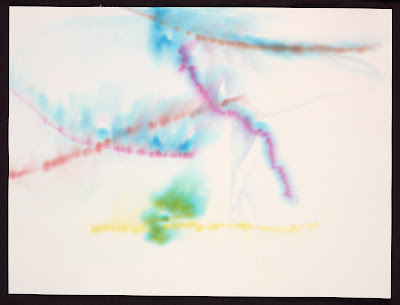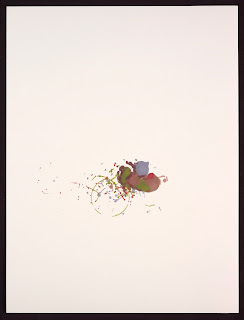
The feel of Rowledge’s work falls somewhere between two Victorian trades that are now almost obsolete: the public letter-writer who copies the thoughts of illiterate passers-by onto paper for the purposes of business or romance, and the psychic, channelling more profound messages from beyond. Rowledge is an interpreter; her work is an emotional response to traces of other people’s existence. For example, she will rescue notes on scraps of paper discarded in London’s gutters, which she gold tools on leather in her studio, the gilt marks true to each original scribble and smudge. In her work as a designer binder she responds to more self-consciously literary texts. A wider political context isn’t part of this creative framework: ‘when I’m working to commission I’m responding to a text, so it won’t necessarily have a reference to anything else – other than my constant preoccupation with painting.’
Rowledge was invited to participate in the Cape Farewell expedition to Disko Bay in 2008, a venture in which 24 creative practitioners travelled up the West Coast of Greenland, observing climate change and making work in response to the experience. I’ve admired Rowledge’s work since seeing her ‘vernacular’ gold tooling at the Crafts Council over a decade ago, and so I was eager to hear her reaction as an artist to the environment I was about to encounter. A little star-struck, I arranged to visit her in her studio in West London to hear how, as a celebrant of human ephemera, she responded to the marks made by man on the Arctic wilderness. We started out by talking about the landscape.
NC: What did you think of the ice?
TR: I was really amazed at how noisy it was. It was annoying that my only points of reference were really banal things, like the blue stripe in toothpaste, when you’re looking at icebergs… it looks like stripy toothpaste and you think 'This is so beautiful, but I don’t know quite how else to look at it.' Or when we were ashore you can hear this noise, and it sounded like a farmer’s boom to scare away birds, but it was the icebergs calving. Really strange. Then I could hear what sounded like a far-away motorway, but it was really just the ice.
NC: All these are quite domestic metaphors …
TR: But it was so alien to me – the landscape, the seascape – that I didn’t quite know how to understand it. At one point I just sat down and did a drawing because I couldn’t take it in. Drawing was quite useful, because it really made me look long and hard at what it was.
NC: What did you draw?
TR: I was drawing the icebergs. Because you’re looking at one and thinking – 'I suppose it’s quite big really' – and when they turn upside down, you can tell, because they have a completely different character to them. And then when they calve, of course, they shift, so it’s really getting to know the nature of what you’re looking at.

Rowledge created three series of ‘Arctic Drawings’. To some extent the works are scientific documents: ‘created’ by the movement of the ship with Rowledge as intercessor, they chart weather and water at a particular instant of time, noted on each drawing alongside the geographical co-ordinates. The scale of the marks and movement is intimate, at times infinitesimal on the large white sheet, and yet one cannot imagine a more direct creative interaction with the vast Arctic environment. Rowledge explains:
'I wanted to use the Arctic water as a way of making images that would become resource material that I could use back in the studio. I took paper with me that I’d researched as being the right kind of paper to apply felt tip to so that the ink would bleed and the image would move. I had the paper cut so it fitted my suitcase and the cabin became my studio. I became very conscious of the movement of the boat and wondered what it would be like if I just leaned over the piece of paper with a pen and used my arm as a pendulum to create a drawing.
'It developed from there. I created the system – but within that there was room for randomness. All I did was decide where I would put the felt tip down and what colour to use. When the felt tip left the paper I would pick up another colour. I collected Arctic water in a cooking pot, and wet the sheet of paper in a baking tray, then left it to air dry in the cabin. They really became like emotional landscapes for me. I just made the work intuitively and I didn’t think too consciously about it. I didn’t think, “Is this finished work? Is it unfinished work? Is it resource material?” I just made it.
'I worked all the time that we were on the boat, and I set up a pendulum under the chair in my cabin, so that when I went ashore the drawings would be recorded in my absence. I recorded the date and time of each so I could get the ship’s coordinates – they are very site specific – a record of our journey.'

'When I returned to London I spent time with the drawings and decided what the orientation was, because of course they could have been any way up and any way round. Some were eliminated; others were kept. As soon as I could see something that was easily readable, something that looked a bit like an animal or a bit like a flower, it was out: they had to be beyond having that type of reference.
'Along the mountboard of each frame it tells the story: ‘2008 – Disko Bay – Cape Farewell Expedition’. In Series 3, for which I used the Arctic water and felt tip, you can see that sometimes the sea was very, very rough. I got up at 5 o’ clock in the morning and captured this very intense movement. Whereas others look rather like algae, they are calmer and more contemplative. In each drawing you got a very different feel.'


'Series No. 1 is made with black felt tip on paper, using the pendulum underneath the chair. It’s so small on such a big piece of white paper. You’re immediately drawn in to the detail. When I first came back and looked at them I didn’t really quite know what to think about them. I wondered if the paper should be cropped. Normally I work in creating systems for mark-making and I would work with the given dimensions of the piece of scrap paper that I had found. So I had to go about processing this new piece of work that I had made. And the more time I spent with it the more it became apparent that the reason it worked was that actually, they were such little locked pieces of movement within a big piece of paper. And they’re not a study. They would become quite ephemeral if they were very small.'


'In Series 2 there were some that were quite big and blobby, but the remaining ones I have are just blocks of colour – this is where the sea was quite calm. What’s really interesting to me about these images, for which I used Letraset pens, is how the colour has maintained its own area. The Letraset pens don’t really bleed into each other so they’ve created really interesting images. I just chose those colours because they were colours that I liked and so I took them with me. And they work well together. That’s really the beauty of chance sometimes.'
NC: I wanted to ask about your ideas on permanence. I know you’ve done a lot of conservation work, and although bookbinding needn’t always be about preservation, it’s a consideration in the field, isn’t it? I’m wondering about these marks – the desire to anchor a moment’s experience in space and time – and how that relates to the world changing – climate changing…
TR: As soon as you feel the weight of what’s happening with climate change you think 'Well, why bother making another object? What’s the point really?' But then you get driven to make something because that’s what it is in your make up to do, to make your ideas physical. They have to exist. You just get focussed on the idea and lose the bigger picture – perhaps that’s survival.

Cambridge 100 Questions Desk
NC: Were there any other projects that came out of the expedition?
TR: There was another idea, which was quite interesting, because I was quite determined that I would not make a book! That would not be my response to climate change. But one evening I was having dinner with Marcus Brigstock and David Nobel, and Marcus asked what was involved in binding a book.
So I explained, and David said, 'Do you know, I think it would be really interesting if you made a book of covenants. You could make a book which would go to "the elders" and it would become a symbol for change, to solve the world’s problems.' So we thought 'Yes, that would be a good idea!' And I laughed inwardly, and thought, 'Are we really discussing making a book?!' But I decided, 'It’s quite interesting. I’m just using myself as a tool. I’ve got the knowledge of how to make a book; why don’t I just use that as a vehicle to promote this message?'
We thought we’d meet every day to discuss the idea, but of course we didn’t because there was so much going on. We did speak about it once or twice. I thought it could be a good idea, but I didn’t really want to be driving it – I wanted a partner, someone who would commission me to make it. Then Joe Smith who was on the trip, and works for the Open University specialising in environmental issues, happened to know that there was a project called The 100 Questions Project run by the Cambridge Programme for Sustainability Leadership. He put Mike Peirce and me together and we worked on a project in which all the Nobel Prize laureates were asked to write questions to push the thinking on climate change and climate justice.
It started off as a book… and it then turned into a desk! Because there was no end to how many questions would be written. It started off with the Nobel Prize laureates and then it filtered down to the public. It could be that 10,000 questions might be generated, and I couldn’t keep adding pages – the book would be so unwieldy, it would end up the size of a room! I’d have to endlessly build more cases. It just wasn’t practical.
I felt that there needed to be closure for it. Well, I like the idea that a particular kind of leather-topped desk feels like the place where key thinkers sit and produce their thoughts… My original idea had been to create a leather panel which I had assumed would go on the wall as a backdrop for the book – or as its cover. This became the traditional leather inset for the desk. The image on it symbolised in an abstract way climate change, movement, the intensity of shifts.
I worked with Carl Clerkin who created the most fantastic desk with a very long, extended drawer, and in the drawer were ten compartments for ten questions that could be changed, as and when. The desk was recently on show at the Fitzwilliam Museum and then we hope that it will tour and be available for a lot more people to see.

